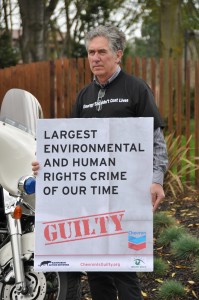The ever-soaring price of gas may have Chevron’s stock riding high, but the company is still facing a massive liability in Ecuador. An independent report released widely today reveals that, despite Chevron’s claims to the contrary, the $18 billion court judgment against the oil giant in Ecuador poses serious financial and operational risks to the company. The report also raises serious concerns about Chevron management’s handling of the long-running Ecuador liability, as well as fundamental board oversight issues.
 After nearly two decades of litigation, on February 14, 2011, the Ecuadorian Provincial Court issued its final judgment in which it found Chevron liable for just over $18 billion in compensatory and punitive damages. This constitutes one of the largest court judgments for environmental damage in history, second only to the $20 billion Gulf Cost Claims Facility that BP was forced to set up in the wake of the Deepwater Horizon disaster.
After nearly two decades of litigation, on February 14, 2011, the Ecuadorian Provincial Court issued its final judgment in which it found Chevron liable for just over $18 billion in compensatory and punitive damages. This constitutes one of the largest court judgments for environmental damage in history, second only to the $20 billion Gulf Cost Claims Facility that BP was forced to set up in the wake of the Deepwater Horizon disaster.
Simon Billenness of Strategy for Corporate Responsibility and Social Investment, a co-author of the report, said:
In sworn legal statements, Chevron has admitted that the company faces “irreparable injury to [its] business reputation and business relationships” from potential enforcement of the Ecuadorian court judgment. However, Chevron has failed to characterize these risks in its public filings. These choices may lead some shareholders to question the adequacy of Chevron’s public statements and disclosures and whether the board and management are fulfilling their fiduciary duties to properly manage this significant risk to the company’s business and value.
Some Key Findings of the report:
- Chevron’s principal legal defense against immediate enforcement of the $18 billion judgment was to obtain a preliminary injunction from U.S. District Court. Over the long term, it is not clear that such an injunction in a U.S. court would protect Chevron from enforcement efforts outside the United States.
- Chevron has also sought to defend itself though international arbitration against the government of Ecuador under the provisions of the Bilateral Investment Treaty (BIT) between the U.S. and Ecuador. At present, these arbitral proceedings are running concurrently with the case in Ecuador. Although Chevron could conceivably obtain money damages from the Ecuadorean government from this process, the arbitral panel has no jurisdiction over the Ecuadorean plaintiffs or the Ecuadorean court system.
- While Chevron has admitted in sworn legal statements that the company is at risk of “irreparable injury to [its] business reputation and business relationships” from potential enforcement of the Ecuadorian court judgment, the company has failed to characterize these risks to the company in its public filings and statements to shareholders.
- These choices may lead some investors to question the adequacy of the company’s public statements and disclosures and whether the board and management are fulfilling their fiduciary duties to properly manage this significant risk to the company’s business and value.
Investors are also starting to catch on to Chevron’s doublespeak. Boston-based Trillium Asset Management and the New York State Common Retirement Fund have begun circulating an investor sign-on statement ahead of the company’s annual shareholder meeting to take place on May 25th at the company’s headquarters in San Ramon, CA. It reads, in part:
In failing to negotiate a reasonable settlement prior to the Ecuadorian court’s ruling against the company, Chevron displayed poor judgment that has led investors to question whether our company’s leadership can properly manage the array of environmental and human rights challenges and risks that it faces.
The co-signors call upon the company “to reevaluate whether endless litigation is the best strategy for the company and its shareholders, or whether a more productive approach, such as reaching a settlement, could be employed to begin to provide for a proper remediation for past environmental damages. In so doing, Chevron can once and for all put this controversy behind it.”
Analysts are also starting to question Chevron’s disclosure. The Sustainable Investment Institute (Si2), a nonprofit investment research organization, has noted the “dramatically different picture” between what Chevron has told U.S. Courts in sworn testimony and what Chevron has revealed to its own shareholders regarding the risks to its business from the Ecuador litigation. Si2 also noted in a special report on Chevron and “Investor Pressures on Sustainability Issues” that if the $18 billion judgment against Chevron were to be enforced it would be equal to almost 95 percent of Chevron’s total net income for 2010.
In late March, stock research company Trefis predicted a decline in its estimate of Chevron’s stock valuation of approximately 5 percent based on the company paying only the $9.5 billion compensatory damages ordered by the Ecuadorian court.
Despite a preliminary injunction issued by U.S. Judge Lewis Kaplan and Chevron’s vow never to pay to clean up its mess in Ecuador, the company is still facing a very real and rather large liability. The Ecuadorean plaintiffs plan to go after Chevron assets around the world, and as Marco Simons at EarthRights International recently observed, Chevron needs to win everywhere the plaintiffs seek to enforce the judgment in order to fully shield itself, whereas the plaintiffs only need to win in a few places to get the money Chevron owes.
We’ll be at Chevron’s Annual General Meeting of Shareholders in San Ramon on May 25th to call for justice for the people of Ecuador, the people of Richmond, CA, the people of Nigeria, and the people of countless other communities around the world that have been devastated by Chevron’s business operations. If you’re in the Bay you should join us!
The Report:
An Analysis of the Financial and Operational Risks to Chevron Corporation from Aguinda v. ChevronTexaco